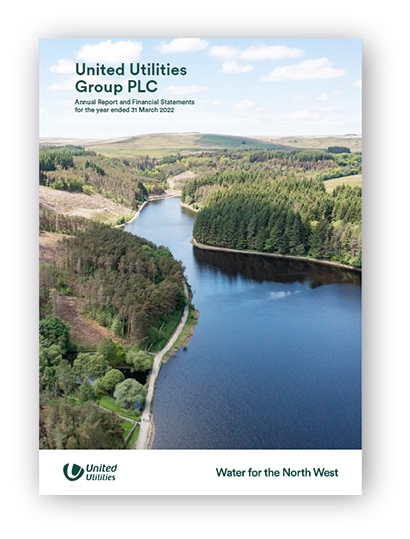
Here we share our greenhouse gas emissions (GHGs) and progress towards meeting our six carbon pledges and science-based targets (SBTs). We present our six most sensitive climate risks and our new adaptation report. In this section, supported with content elsewhere in this integrated report and on our website, we include disclosures consistent with the TCFD Recommended Disclosures all sector guidance.
Reduce scope 1 & 2 emissions
↓ 2.2% compared to baseline
We are making good progress towards our science-based target to reduce scope 1 and 2 emissions by 42% from our baseline by 2030.
2021/22: 135,936 tCO2e
2019/20: 138,961 tCO2e (baseline year)
100% of electricity used from renewable sources
We achieved this pledge from October 2021
From October 2021 the electricity we purchased was from guaranteed renewable sources. In addition, we generated a record 210 GWh of renewable energy in 2021/22, equivalent to 26% of our total electricity consumption.
100% green fleet by 2028
27 fully electric vehicles (EV) now deployed in our fleet with plans for 200 low carbon vehicles by 31 March 2025
We have installed advanced telematics to improve understanding of travel patterns and are trialling options for larger vehicles. We are enabling employees to shift to EV through changes to the company car policies and launch of a salary sacrifice scheme ‘EVolve’.
1,000 hectares of peatland restoration by 2030
Restoration activity well underway
We have restoration projects across the North West at different stages of maturity. As well as continuing our site work to completion, we aim to become an early pioneer in applying the Peatland Code at scale to independently verify the carbon benefits.
Create 550 hectares of woodland by 2030
9 hectares planted and validated to the Woodland Carbon Code
Planting in 2021 was postponed due to weather and tree disease. The remaining 541 hectares have been planned and the funding identified.
Set scope 3 science-based target
Targets verified by SBTi
Emissions from our value chain are the most challenging to address so we are working with our supply chain. We are exploring how to improve our calculation methods for scope 3 emissions so that we can consider and openly report the impact of our management choices.
Reduce scope 1 & 2 emissions
2.2% compared to baseline
We are making good progress towards our science based target to reduce scope 1 and 2 emissions by 42% from our baseline by 2030.
2021/22: 135,936 tCO2e
2019/20: 138,961 tCO2e (baseline year)
100% of electricity used from renewable sources
We achieved this pledge from October 2021
From October 2021 the electricity we purchased was from guaranteed renewable sources. In addition, we generated a record 210 GWh of renewable energy in 2021/22, equivalent to 26% of our total electricity consumption.
100% green fleet by 2028
27 fully electric vehicles (EV) now deployed in our fleet with plans for 200 low carbon vehicles by 31 March 2025
We have installed advanced telematics to improve understanding of travel patterns and are trialling options for larger vehicles. We are enabling employees to shift to EV through changes to the company car policies and launch of a salary sacrifice scheme ‘eVolve’.
1,000 hectares of peatland restoration by 2030
Restoration activity well underway
We have restoration projects across the North West at different stages of maturity. As well as continuing our site work to completion, we aim to become an early pioneer in applying the Peatland Code at scale to independently verify the carbon benefits.
1,000 hectares of peatland
9 hectares planted and validated to the Wo
We have installed advanced telematics to improve understanding of travel patterns and are trialling options for larger vehicles. We are enabling employees to shift to EV through changes to the company car policies and launch of a salary sacrifice scheme ‘eVolve’.
Set scope 3 science-based target
Targets verified by SBTi
Emissions from our value chain are the most challenging to address so we are working with our supply chain. We are exploring how to improve our calculation methods for scope 3 emissions so that we can consider and openly report the impact of our management choices.
TCFD definition
How the organisation identifies, assesses and manages climate-related risks.
Progress this year
Future focus
TCFD definition
The organisation’s governance around climate-related risks and opportunities.
Progress this year
Future focus
TCFD definition
The metrics and targets used to assess and manage climate-related risks and opportunities.
Progress this year
Future focus
TCFD definition
How climate-related risks and opportunities impact the organisation’s businesses, strategy and financial planning.
Progress this year
Future focus


Our approach to climate change
Our approach to Task Force on Nature-related Financial Disclosures (TNFD)
Our risk management
Energy and carbon report